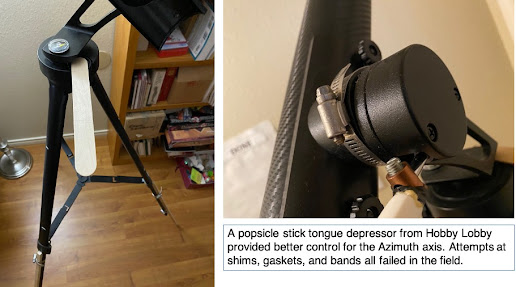The Vixen Company, Ltd., of Saitama, Japan, (founded 1949) got the brilliant idea to make all of their telescopes compatible with all of their mounts. Today, the Vixen mount is a standard offered by most other makers. However, a new Vixen mount bar at $79.95 plus tax and shipping was wholly disproportionate to my needs.
 |
| https://global.vixen.co.jp/en/ |
All-in-all it has been a good little viewer and given the 70-mm limit not half bad for backyard stargazing. At that time, I also owned a Celestron EQ-130 Newtonian which I donated to the Goodwill earlier this year.
I am not a fabricator. I have very few tools here. So, I went to Home Depot and searched for wood. I bought a 24-inch slat of quarter-inch poplar.
With the saw blade on my Gerber pocket tool, I cut it in thirds and glued two pieces together. (I learned about Elmer's in junior high wood shop class.)
The attachment screws on the telescope are mounted from the inside and I did not want to take those screws out. So, I used them to attach the new plate. Lacking drill bits, I used wood screws to make the holes. (We have an electric hand drill that my wife got as a door prize at a computer user meeting.) I ran a thin one in first, then widened it.
Even though I measured more than twice, I was off by an inch the first time. I also split the wood once with a screw too large. After gluing (and curing) that, I wided the holes with my Swiss Army Knife.
I secured the slat to the telescope with Gorilla glue.
The best telescope is the one that gets used.
I recently bought entry-level Celestron "First Scope" oculars ("eyepieces") to go with this so-called "hobby killer" that my astronomy colleagues denigrate for being a "department store telescope." OK: it is not an apochromatic rare earth triplet; the aperture (diameter) is not four inches or eight or ten. Nonetheless, I have seen the Messier 22 globular cluster, the Messier 44 "Beehive" open cluster, the Andromeda Galaxy (Messier 31), and, of course, Venus, Mars, Jupiter, and Saturn. Now, the telescope has a mount worthy of its optics.
PREVIOUSLY ON NECESSARY FACTS
(Mostly, the addenda links can be complementary or contrasting or off-topic. These are about observing with the National Geographic 70-mm refractor.)







No comments:
Post a Comment
Note: Only a member of this blog may post a comment.